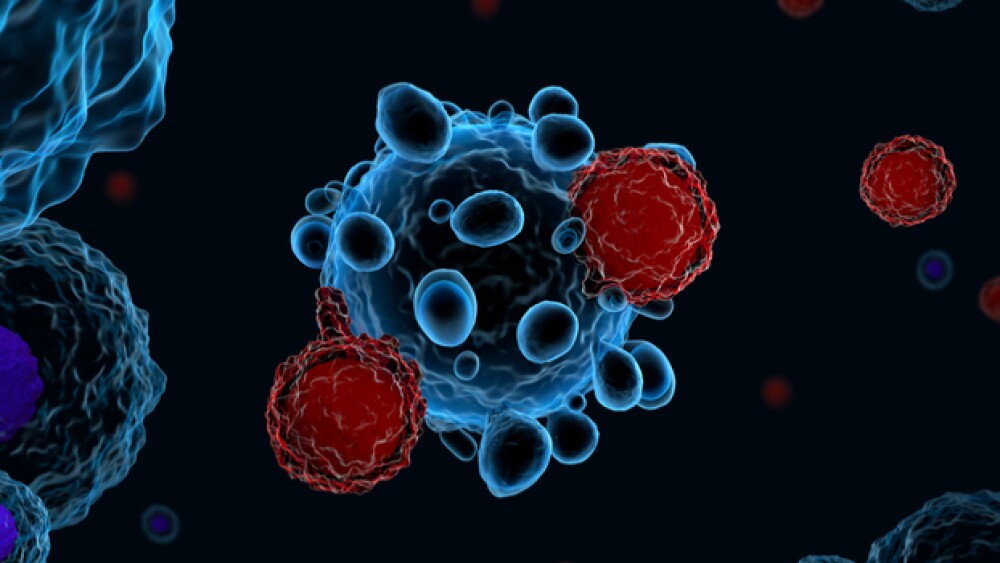What if you could more precisely control CAR-T cells using FDA-approved small molecules to enhance their activity against solid tumors? That’s exactly what Obsidian Therapeutics is aiming to do.
Despite the success of CAR-T therapies for B-cell cancers and multiple myeloma, developing CAR-T therapies for solid tumors has posed more of a challenge. Failure of the CAR-T cells to multiply to high enough levels, the tumor microenvironment being immunosuppressive, and tumor cells ‘escaping’ the therapy by losing target antigen expression are just some of the obstacles solid tumors pose.
What if you could more precisely control CAR-T cells using FDA-approved small molecules to enhance their activity against solid tumors? That’s exactly what Obsidian Therapeutics, a Cambridge, MA-based biotech company, is aiming to do.
Building on strategies to turn ‘cold’ tumors ‘hot’
If the immune system cannot recognize or interact with a tumor due to its ‘cold’ (or immunosuppressive) microenvironment, then no immunotherapy will be effective against it. Figuring out how to turn a ‘cold’ unresponsive tumor into a ‘hot’ immune cell accessible tumor is one of the next largest challenges to overcome.
Some companies, such as Immunovative Therapies, are creating vaccines and patented immune cells to make ‘cold’ tumors ‘hot.’ Other companies are focusing on altering specific immune cells to ‘heat up’ cold tumors. Venn Therapeutics is focusing on transforming growth factor-beta (TGF- β), an immune cell called a cytokine that regulates the immune system. They developed an antibody against an integrin (a receptor expressed on the outside of cells, especially prevalent on tumors as they progress) that interacts and activates TGF-β. The idea is that blocking TGF-β blocks how much growth factor the tumor recruits, thereby slowing tumor growth.
Checkmate Pharmaceuticals’ lead drug candidate is a specific type of short synthetic DNA molecule (a CpG oligonucleotide) that activates a receptor (toll-like receptor 9, TLR-9) on certain immune cells (plasmacytoid dendritic cells, pDCs) around a tumor. Once activated, these immune cells recruit other immune cells to the tumor, making the tumor ‘hot.’ This can be paired with checkpoint inhibitors (a certain type of immunotherapy drug) to enhance the anti-tumor immune system effect.
ZIOPHARM is developing a genetically controlled interleukin-12 (IL-12) platform that works either as a monotherapy or with checkpoint inhibitors. IL-12 stimulates the immune system to recognize cancerous cells, regardless of tumor antigen, but it needs to be selectively activated to avoid undesirable side effects. An adenovirus vector carrying the genetic ‘switch’ and gene for IL-12 is injected directly into the tumor, localizing IL-12 expression to just the tumor. To turn on IL-12 expression in the tumor, the patient takes a capsule of a drug (Veledimex); IL-12 expression is dose-dependent, so the amount of Veledimex taken correlates to the amount of IL-12 expression in the tumor.
Enhancing CAR-T therapies against solid tumors
Boosting the immune system in and around a tumor should help CAR-T therapy efficacies against solid tumors. To target solid tumors, activating other immunomodulatory molecules, such as IL-12 and Cluster of Differentiation 40 ligand (CD40L), may enhance the potency of CAR-T, so there has been interest in how to best activate those molecules. However, using separate antibodies and other activators have caused systemic toxicity, which has limited their applicability.
Expressing IL-12 or CD40L on the CAR-T cell itself to create a “multifunctional” CAR-T cell may be another option of enhancing its effect, but how can you specifically control the activity of IL-12 or CD40L to avoid unwanted side effects?
Obsidian is developing a synthetic biology platform consisting of three parts: a small protein (called a drug-responsive domain, DRD), a therapeutic protein (attached to the DRD), and a small molecule drug (that binds to the DRD). There are multiple small molecules that can be used, and the therapeutic protein options are theoretically endless. In this case, Obsidian is attaching the DRD to either IL-12 or CD-40L (the therapeutic proteins), then the fusion protein can be expressed by CAR-T cells based on the presence or absence of the small molecule.
The overall idea is that the therapeutic protein activity can be controlled via addition of the small molecule drug. The DRD-therapeutic protein complex is made inside the CAR-T cell; whether the complex is degraded or remains active can be controlled by adding the small molecule drug. The drug can enter into the CAR-T cell and interact with the DRD protein. If the small molecule is not present, then the DRD is unstable and both the DRD and attached therapeutic protein are rapidly degraded. If the small molecule is present, it binds to the DRD and stabilizes it, which allows the DRD and therapeutic protein to persist and be expressed by the CAR-T cell, where it can function normally. This platform can be controlled in a dose-dependent manner by adding more or less small molecule drug: add a little and only some of the DRD-protein complex is expressed, add a lot and all of the DRD-protein complex is expressed.
“It’s like a light switch dimmer – the therapeutic protein’s function can be directly controlled by how much small molecule drug we add,” Paul Wotton, CEO of Obsidian, told BioSpace. “Our platform allows for precise pharmacological control of protein activity in cell therapies for the first time.”
Obsidian’s technology could enhance cell therapies in multiple ways, depending on the function of the therapeutic protein. In addition to altering the tumor microenvironment to turn a ‘cold’ tumor ‘hot,’ this platform can be used to control proteins that increase cell persistence, modulate antigen recognition, and reduce or eliminate the need for preconditioning before treatment.
Controlling proteins with small molecules
Obsidian’s technology is based off of research done by Thomas Wandless at Stanford University, who has studied how to control protein stability using FDA-approved small molecule drugs. In 2006, his lab designed proteins that are not stable and are rapidly degraded in cells. However, these unstable proteins can be stabilized when they bind to certain small molecules (hence their name “drug-responsive domains” or DRDs), preventing their degradation and allowing the protein to remain intact.
The Wandless lab also fused the DRD protein to another protein, whose function could be directly controlled by the DRD: if the DRD was left unstable, both proteins would be rapidly degraded, but if the DRD was stabilized by a small molecule, then both the DRD and its fused protein would persist in the cell, allowing the fused protein to be active and perform its function.
The Wandless lab took this platform a step further a few years later when they demonstrated its utility in mice. By fusing the DRD to a fluorescent protein, protein expression in the mice could be tracked using bioluminescence imaging. The peak fluorescent protein expression occurred 12 hours after administering the small molecule to the mice and lasted for 48 hours after administration.
They next wanted to show that this platform could be applied to a therapeutically relevant protein in mice. They fused the DRD to IL-2, another type of cytokine that regulates other immune cell formation and is used in some cancer therapies. First, they tested the response of the DRD-IL2 protein expression in human cells to increasing concentrations of small molecule. A dose-dependent increase in DRD-IL2 protein expression was seen and the DRD-IL2 protein was functional, both of which are important for the overall therapeutic relevance of this technology.
In mice with xenograft tumors (tumors created from human cancer cells) that also express the DRD-IL2 fusion protein, treatment with the small molecule every 48 hours shrank the tumors over time, with the treated group showing significantly smaller tumors compared to untreated animals at day 16. Although there were no significant differences in tumor burden between the mice treated with a low (5 mg/kg) or high (10 mg/kg) dose of small molecule, the higher dose created a significantly higher concentration of the DRD-IL-2 fusion protein within the tumor and in the blood, indicating that the response is still dose-dependent in an animal model.
Applying this controllable protein platform to CAR-T cells
Now, Obsidian has applied this platform to CAR-T cells, leveraging synthetic biology and computer modeling to design and optimize DRD proteins. After testing the DRD-therapeutic protein pairs in cells and animal models, the complex is added into CAR-T cells via a viral vector, where its expression on the CAR-T cell surface is regulated by the absence or presence of the small molecule.
The patient would be intravenously infused with the CAR-T cells, then given the small molecule drug to activate expression of the therapeutic protein from the CAR-T. The therapeutic protein could then perform its normal function. Therapeutic proteins that Obsidian are exploring include IL-12, CD40L, and IL-15, which all modulate the immune system. The small molecule drugs are already FDA-approved, allowing for easy dispensing by the physician and a known safety profile.
In a recently announced partnership with Celgene earlier this year, Obsidian and Celgene are pursuing Obsidian’s therapeutic platform using the destabilizing domain technology to control IL-12 and CD40L expression in cell therapies for oncology.
So far, all of Obsidian’s platform research has been preclinical, but Obsidian is currently designing IND-enabling studies to bring its research into clinical trials.





